When it comes to building a serious set of arms (and a monstrous back), few exercises can offer the strength and muscle hypertrophy stimulus as the chin-up. The chin-up, when included as part of a balanced push/pull routine or trained on its own, offers strength, size, and functionality benefits to all athletes.
In this exercise guide we’re setting out to equip you with the information you need to maximize your chin-up strength, skill, and performance.
- How to Do the Chin-Up
- Benefits of the Chin-Up
- Muscles Worked by the Chin-Up
- Who Should Do the Chin-Up
- Chin-Up Programming Recommendations
- Chin-Up Variations
- Chin-Up Alternatives
- Frequently Asked Questions
How to Do the Chin-Up
Below is a step-by-step guide on how to properly set up and perform the chin-up with picture-perfect technique.
Step 1 — Get Your Grip
Start by assuming a supinated (underhand) grip on a bar with your hands about shoulder-width apart. One of the defining elements of the chin-up is the grip itself.
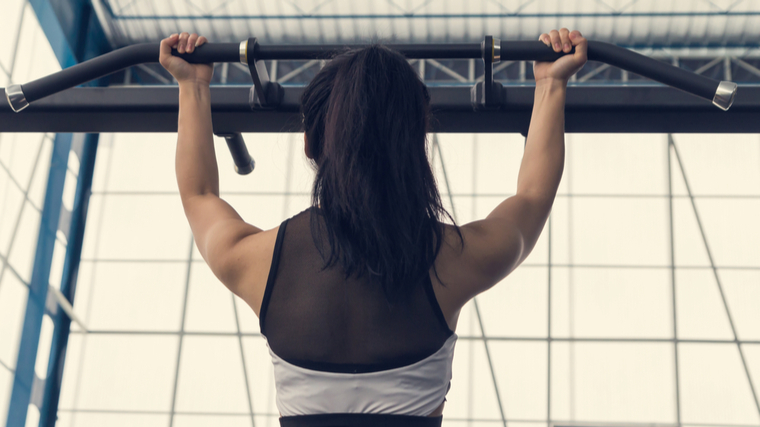
Coach’s Tip: Be sure to freely hang at the bottom of the chin-up. You should be able to have your head in between your biceps with the elbows fully extended.
Step 2 — Set Your Core
Tuck your pelvis so it is in a slight posterior position. Brace your core as if you were performing a plank, and then take a deep breath, inflating the abdomen.
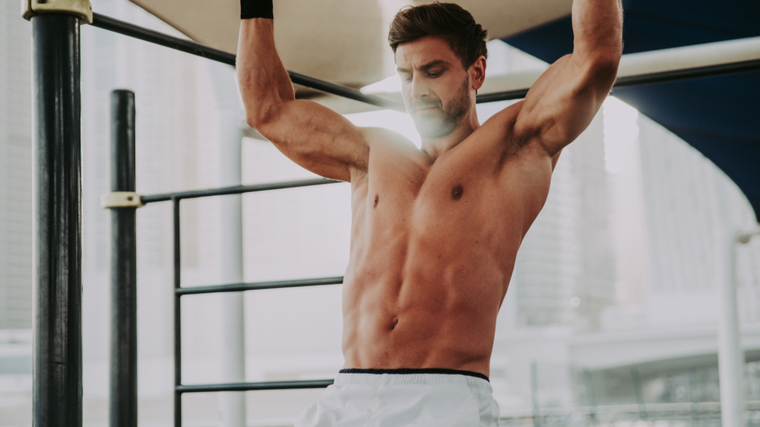
Coach’s Tip: By setting the core, you’ll be providing a more stable structure for the muscles of the shoulders and back to contract against. A rigid midline should also reduce swaying and momentum during the movement.
Step 3 — The Pull
Once you’re set and stable, pull yourself up to the bar you’re hanging from by way of contracting the back and biceps.
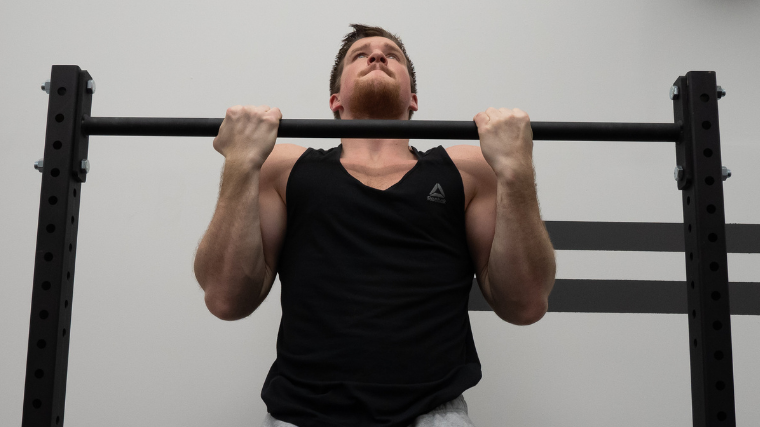
Coach’s Tip: Think about pulling the bar to your chest so that your elbows drive into your back pockets. You can also think about driving the elbows through the floor as you pull yourself upwards.
Step 4 — Stabilize and Descend
Once you’ve pulled up enough that your chin is as high as the bar, pause for a brief moment if possible before lowering back down under control.
Coach’s Tip: Be sure to keep tension on the back and biceps throughout the eccentric, and always secure your core prior to proceeding into another repetition.
Benefits of the Chin-Up
Below are three benefits of chin-ups that athletes from most strength, power, or fitness sports can expect when implementing chin-ups into a training regimen.
Upper Body Functional Strength
For most athletes, the ability to pull oneself up to the bar will increase arm and back size, build serious grip strength, and improve general performance. For others, this could be a key movement to enhance endurance or augment pulling abilities with things like deadlifting, strongman exercises, and CrossFit movements.
Bigger Biceps and Forearms
The chin-up, unlike the pull-up, places high amounts of load on the biceps due to the supinated grip on the bar. In doing so, the bicep must work overtime to help lift the athlete up towards the bar.
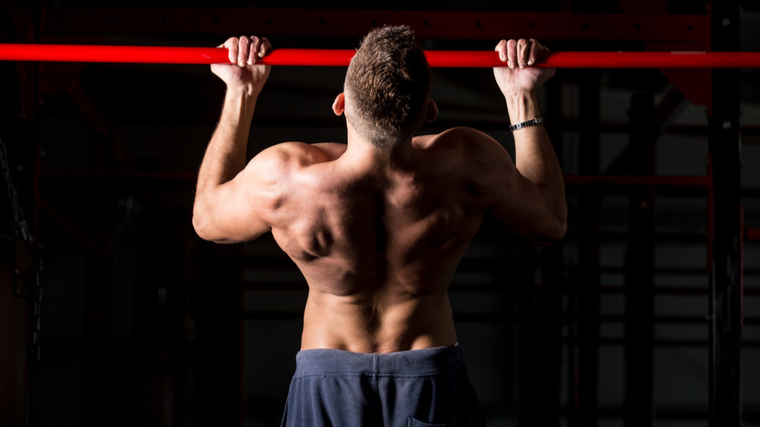
Due to the high amount of loading that is often placed on the biceps and forearms during the chin-up (either due to added weight or simply the weight of the individual), this exercise is stellar for producing muscle hypertrophy and strength gains in the biceps, forearms, and back.
Master Your Bodyweight
Being able to move your own body in a wide array of movement patterns is key for most sports. While some strength and power athletes may not directly need to do gymnastic movements — though they can certainly help — the pure strength and mass needed for larger athletes to do chin-ups can translate into a stronger back, biceps, and forearms.
This auxiliary strength development will help with presses, deadlifts, carries, snatches, and everything in between.
Muscles Worked by the Chin-Up
The chin-up is an upper body exercise that can be done to increase back, arm, and overall pulling strength and hypertrophy. Below is a breakdown of the primary muscle groups involved.
Biceps
The chin up targets the biceps due to the supinated grip that is taken on the bar. In doing so, you force high amounts of elbow flexion, which is the biceps primary role.
Lats
The primary back muscles (latissimus dorsi) are active in the chin-up similarly to the pull up, row, and other back movements. While the biceps do play a larger-than-typical role in force production, the chin-up is still a pulling movement. This means that the lats are still pulling their weight (and then some) in every rep.
Forearms and Grip
A strong grip and forearms are needed to both keep you holding on to the bar itself as well as provide a stable connection to pull from. Additionally, the change in grip provides an alternative stimulus to coaches or athletes looking to switch up their training.
Who Should Do the Chin-Up
Chin-ups can be seen everywhere from high school gym classes to professional athletic facilities. If their versatility isn’t enough of a selling point, however, we can get more specific. Below are some reasons why just about anyone can benefit from performing the chin-up.
Strength and Power Athletes
When maximal strength and performance is the name of the game, we often want to look at accessory exercises that allow us to target the muscles used in our main lifts as well as bump up our training volume without inducing too much extra fatigue.
The chin-up can be used as a back and arm accessory exercise, much like the pull-up, to increase general pulling strength, and improve your grip strength so you can perform better with the barbell.
Functional Fitness Athletes
The chin-up, while not often found in competitive CrossFit workouts (unlike kipping pull ups, muscle-ups, rope climbs, etc) does offer overall upper body strength, hypertrophy, and endurance benefits.
Integrating chin-ups into programs can offer much needed training variety and offer new stimuli to potentiate muscle growth, minimize overuse injuries, and improve work capacity.
Regular Gymgoers
The chin-up is a foundational bodyweight exercise. Even if you aren’t interested in competing in a strength sport, there are certain benchmark movements that are fantastic for a general exercise routine.
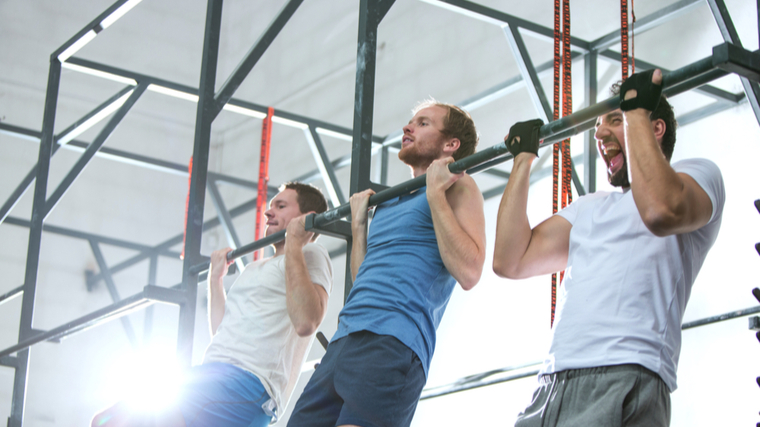
The chin-up is versatile, requires little to no equipment, is beginner-friendly for technique, and offers a multi-joint stimulus to keep you in shape and healthy overall.
Chin-Up Programming Recommendations
Once you’ve decided that the chin-up has a place in your routine, the next step is taking action. Below are three sets, reps, and intensity recommendations for coaches and athletes to properly program the chin-up based on training goal.
Note that the below guidelines are here to offer coaches and athletes loose recommendations for programming, and are not to be taken as gospel.
To Gain Muscle Mass
The chin-up can be used to increase upper body mass in the arms, back, and forearm muscles. If you have issues performing these with good form for this many repetitions, using a band for assisted leverage or switching to an easier alternative can still help you stimulate the muscles you want to grow.
Start by performing 4-6 sets of 6-12 repetitions, resting 60-90 seconds between, with additional loading as needed.
To Improve Upper Body Strength
For general strength building, the best practice is to perform lower repetition ranges for more total sets. You can program these very similar to other strength-building progressions, however be sure to have a good foundation of technique.
Start by performing 4-6 sets of 2-5 repetitions, resting 2-3 minutes, with added weight if possible.
To Increase Endurance
If you want to kick your endurance up a notch, higher repetition ranges and/or shorter rest periods are recommended. If you cannot perform many chin-ups with good form, you can use band assistance to help you get your reps in.
Start by performing 2-3 sets of 12+ repetitions, resting as needed based on your sport or primary activity, aiming to increase total reps performed over time.
Chin-Up Variations
If the chin-up itself isn’t your cup of tea, don’t fret. There are plenty of ways to dress the movement up (or down) so it’s fresh, fun, and functional. Below are three chin-up variations that can be used to keep training varied and progressive.
Weighted Chin-Up
The weighted chin-up is simply a chin-up performed while wearing a weighted vest, having a weight belt on, or simply by squeezing a dumbbell between your legs. The weighted chin-up is a huge step up in intensity, but the strength and size benefits are just as potent.
Eccentric Chin-Up
The eccentric chin-up variation is beneficial for individuals who may lack the overall strength or muscle mass to perform full chin-ups.
By simply performing the lowering phase of the exercise with slow cadence, either with just body weight or added resistance, can help you acclimate to the movement overall and get you closer to your first rep. Once you can perform several strict negatives, you can probably hit your first true chin-up.
Chin-Up “21’s”
Similarly to bicep curl 21’s, chin-up 21’s are an advanced repetition scheme that can be done to increase strength and muscle hypertrophy in the chin-up. Simply perform seven partial chin-ups at the bottom half (bottom to half way), seven partial chin-ups at the top half (halfway to top), and then seven full range of motion chin-ups. This will incur a serious amount of fatigue in your back and arms, but should also bring with it significant strength and size gains.
Chin-Up Alternatives
If none of the above variations tickle your fancy, or you don’t have access to a fixed bar in your home or gym, we’ve got you covered. Below are three alternatives that should wonderfully substitute for the chin-up.
Pull-Up
The pull-up is a staple bodyweight strength and hypertrophy exercise implemented in most strength, power, or functional fitness programs. This is very similar to the chin-up, however it does target more of the back muscles specifically and places less emphasis on the biceps. If you’re really trying to broaden your back, the pull-up might be particularly potent.
Underhand Row
The underhand/supinated barbell row is very similar to the chin-up and can increase bicep strength and hypertrophy. That said, many lifters will find they can use significantly more load with the underhand row, further increasing muscle stimulus and growth potential to the biceps. If calisthenics make you shiver, the underhand row can fill the programming gap provided by the chin-up.
Underhand Pulldown
The mechanics of the chin-up can be mirrored on a cable station by performing a standard pulldown with an underhand grip. In fact, the upper body mechanics of the cable pulldown and the chin-up are basically identical.
If you’re not interested in building up your endurance or core stability, but still want to demolish your lats, traps, and biceps, the underhand pulldown is a fantastic substitute.
Final Word
There’s no one-size-fits-all exercise, and no single movement can cover all the bases provided by the right routine. However, if we had to pick just one exercise to perform for strength, size, and stability in the back, the chin-up is in a league of its own.
Frequently Asked Questions
It’s more than okay to still have some lingering questions. Even a movement like the chin-up, which looks simple at face value, has an element of intricacy to it. Let’s get into some common questions and clear the air.
Is it okay to do kipping chin-ups?
Kipping, when performed improperly, can end up placing high amounts of strain and stress on the connective tissues of the elbow and shoulder.That said, kipping is a foundational aspect of many CrossFit workouts, and can be performed safely, but it is not recommended for the chin-up.
If you are having issues doing strict chin-ups, consider utilizing bands, while also strengthening the muscles with movements like underhand rows, underhand pulldowns, and curls.
What is the difference between a chin-up and a pull-up?
The main difference between the chin-up and the pull-up is the grip taken on the bar, and how that grip impacts which muscles are used in the movement. The name itself refers to the height at which you pull your body up — just to chin level — but this is also a consequence of hand position.
The chin-up has you take a supinated grip on the bar (palms facing you), which increases the amount of biceps used, whereas the pull-up uses relatively more back and less biceps due to the pronated grip (palms facing away).
Can I do chin-ups every day?
Actually, yes! Calisthenics or bodyweight training is one of the best types of work to do on a daily basis. However, you still have to account for total volume to avoid overtraining or possibly creating an injury.
Featured Image: Flamingo Images / Shutterstock